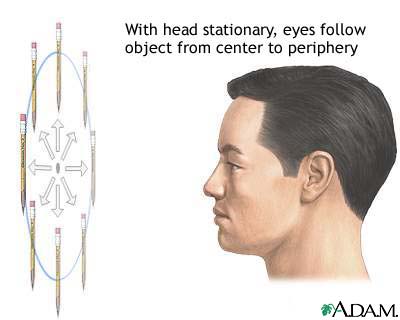Extraocular muscle function testing
EOM; Extraocular movement; Ocular motility examination
Extraocular
muscle function testing is an examination of the function of the eye
muscles. A doctor observes the movement of the eyes in six specific
directions.
How the Test is Performed
You
are asked to sit or stand with your head erect and a forward gaze. Your
health care provider will hold a pen or other object 12 inches in front
of your face. He or she will then move the object in several directions
and ask you to follow it with your eyes, without moving your head.
How to Prepare for the Test
No special preparation is necessary for this test.
How the Test Will Feel
The test involves only normal movement of the eyes.
Why the Test is Performed
This
test is performed to evaluate any weakness or other problem in the
extraocular muscles, which may result in double vision or rapid, uncontrolled eye movements.
Normal Results
Normal movement of the eyes in all directions.
What Abnormal Results Mean
Eye
movement disorders may be due to abnormalities of the muscles
themselves or problems in the sections of the brain that control these
muscles. Your doctor will discuss any abnormalities identified.
Risks
There are no risks associated with this test.
Considerations
Slight nystagmus that stops quickly is normal with an extreme sideways gaze.
References
Baloh RW. Neuro-ophthalmology. In: Goldman L, Ausiello D, eds. Cecil Medicine. 23rd ed. Philadelphia, Pa: Saunders Elsevier; 2007:chap 450.
Lavin
PJM. Eye movement disorders: diplopia, nystagmus, and other ocular
oscillations. In: Bradley WG, Daroff RB, Fenichel GM, Jankovic J, eds. Bradley: Neurology in Clinical Practice. 5th ed. Philadelphia, Pa: Butterworth-Heinemann Elsevier; 2008:chap 16.
source:http://www.nlm.nih.gov/medlineplus/ency/article/003397.htm



